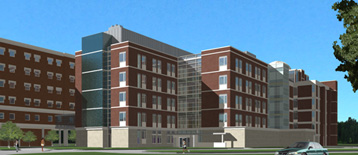Welcome to Mike Steehler's AE Senior Thesis e-Portfolio
Building Statistics
Building Name: University of Rochester BME / Optics Building
Location: University of Rochester River Campus - Rochester, NY
Building Occupant: Biomedical Engineering Department and Institute of Optics
Function: Laboratory / Research / Office / Classroom (4th and 5th floors unoccupied, function yet to be determined)
Size: 100,000 sq. ft.
Stories: 5 stories above grade, plus mechanical penthouse and partial basement
Project Team:
Owner: University of Rochester
Architect: Perkins & Will - Boston, MA
Structural Engineer: LeMessurier Consultants - Cambridge, MA
Associate Architect / Structural Engineering Documentation: SWBR Architects & Engineers - Rochester, NY
General Contractor: LeChase Construction - Rochester, NY
Civil Engineer / Surveying: Parrone Engineering - East Rochester, NY
MEP / Fire Protection: M/E Engineering, P.C. - Rochester, NY
GeoTechnical: Foundation Design, P.C. - Rochester, NY
Cost Estimating: NPV, Inc. - Fairport, NY
Construction Dates: May 2005 - December 2006 (expected)
Total Project Cost: $37.7 million
Delivery Method: Design - Bid - Build
Primary Code: 2002 Building Code of New York State, referencing IBC 2000 and ASCE 7-98
Architecture
The BME / Optics Building will be the new home for the Biomedical Engineering and Optics departments at the University of Rochester. It is a five story structure on a relatively large footprint that will be used for various teaching laboratories, research facilities, a lecture hall, and offices. Although it is being built adjacent to the existing Wilmot Hall on two sides, it was designed as a stand-alone structure, with isolation joints that increase in size with the height of the building. The BME / Optics Building also has a pedestrian bridge to the nearby Computer Studies/Carlson Library Building. This new facility is intended, both symbolically and functionally, to be a link between optics and medicine, two of the featured programs at the University of Rochester.
Although the red brick exterior and rectangular shape is typical for buildings at U of R and many other college campuses, there are a few architectural features that set this building apart. Three angular entrance canopies are cantilevered out the give a “floating” appearance. The architectural hallmark of this building is the 80+ foot tall atrium inside the main entrance, lit by skylights. Stairs are cantilevered into the atrium from the floors to continue the “floating” effect. Interior glazing at corridors on every floor provide views into the atrium.
Envelope
The building envelope varies, but consists entirely of non-load bearing walls. The primary exterior wall is 3” limestone veneer to the second floor and 4” standard brick above, with metal stud backup. Window openings at these sections of the building are 6’-4” wide and vary in depth, not exceeding 10’-8”. In addition, there is a channel glass system at the stairwells, standing seam metal siding at the mechanical penthouse level, and a few sections of an aluminum/glass curtain wall system.
Roofing
The roofing system is primarily a cold process built-up roof using 3” metal deck. It is at ¼” slope with primary and auxiliary roof drains and a parapet wall. This section of the roof also has 3 large skylights above the atrium. The west side of the building has a metal clad, curved slope roof. This system uses 3” roof deck at a radius sitting on rolled W8 steel shapes over the mechanical penthouse.
Structural
The structural system of the BME / Optics Building consists of 4 ½” concrete slabs on 3” composite metal deck, supported by composite steel beams and girders. Varying bay sizes and spans cause beams to vary in size from W10x12 to W18x35, and girders from W16x26 to W21x50. Columns arMay 8, 2007n weight. The foundation consists of H-piles and pile caps, with grade beams at exterior walls and framing around the existing steam tunnel. The building is laterally supported by concentrically braced frames in the East-West direction and ordinary moment frames in the North-South direction.
Mechanical
The mechanical system of the building is supplied by an existing utility tunnel that runs under the footprint of the building, providing high pressure steam, pumped condensate, cogeneration water, and chilled water. A large mechanical penthouse contains air handling units that utilize glycol preheat, reheat coils, chilled water coils, and humidifiers. The laboratory space of the building required special consideration to pressurization and ventilation of laboratories, as well as plumbing needs including nitrogen, deionized water, and acid waste.
Lighting
The lighting methods in this building vary based on usage. Laboratory and mechanical space use surface mounted flourescent lighting, while recessed flourescent lighting is used in offices, and recessed downlights light corridors, lounge areas, and the lecture hall.
Electrical
The electrical system uses a 277/480V substation powered by a 1000/1500 kVA 3 Φ cast coil transformer and a 120/208V substation powered by 750/1125 kVA 3 Φ cast coil transformer. There is also an 800kW diesel emergency generator with bypasses for life safety and critical equipment.
